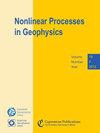Using a hybrid optimal interpolation–ensemble Kalman filter for the Canadian Precipitation Analysis
IF 2.4
4区 地球科学
Q3 GEOSCIENCES, MULTIDISCIPLINARY
引用次数: 1
Abstract
Abstract. Several data assimilation (DA) approaches exist to generate consistent and continuous precipitation fields valuable for hydrometeorological applications and land data assimilation. Usually, DA is based on either static or dynamic approaches. Static methods rely on deterministic forecasts to estimate background error covariance matrices, whereas dynamic approaches use ensemble forecasts. Associating the two methods is known as hybrid DA, and it has proven beneficial for different applications as it combines the advantages of both approaches. The present study intends to explore hybrid DA for the 6 h Canadian Precipitation Analysis (CaPA). Based on optimal interpolation (OI), CaPA blends forecasts and observations from surface stations and ground-based radar datasets to provide precipitation fields over the North American domain. The application of hybrid DA to CaPA consisted of finding the optimal linear combination between (i) an OI based on the Regional Deterministic Prediction System (RDPS) and (ii) an ensemble Kalman filter (EnKF) based on the 20-member Regional Ensemble Prediction System (REPS). The results confirmed the known effectiveness of the hybrid approach when low-density observation networks are assimilated. Indeed, the experiments conducted for the summer without radar datasets and for the winter (characterized by very few observations in CaPA) showed that attributing a relatively high weight to the EnKF (50 % and 70 % for summer and winter, respectively) resulted in better analysis skill and a reduction in false alarms compared with the OI method. A deterioration in the moderate- to high-intensity precipitation bias was, however, observed during summer. Reducing the weight attributed to the EnKF to 30 % alleviated the bias deterioration while improving skill compared with the OI-based CaPA.使用混合最优插值-集合卡尔曼滤波器进行加拿大降水分析
摘要存在几种数据同化(DA)方法来生成对水文气象应用和陆地数据同化有价值的一致和连续降水场。通常,DA基于静态或动态方法。静态方法依赖于确定性预测来估计背景误差协方差矩阵,而动态方法使用集合预测。将这两种方法相结合被称为混合DA,事实证明,它结合了两种方法的优点,对不同的应用都是有益的。本研究旨在探索6 h加拿大降水分析。基于最优插值(OI),CaPA融合了地面站和地面雷达数据集的预测和观测,以提供北美地区的降水场。混合DA在CaPA中的应用包括找到(i)基于区域确定性预测系统(RDPS)的OI和(ii)基于20成员区域集合预测系统(REPS)的集合卡尔曼滤波器(EnKF)之间的最佳线性组合。结果证实了当低密度观测网络被同化时,混合方法的已知有效性。事实上,在没有雷达数据集的夏季和冬季进行的实验(在CaPA中观察到的数据很少)表明,将相对较高的权重归因于EnKF(50 % 和70 % 分别针对夏季和冬季)导致了与OI方法相比更好的分析技巧和错误警报的减少。然而,在夏季,观察到中等强度到高强度的降水偏差有所恶化。将EnKF的重量减少到30 % 与基于OI的CaPA相比,在改善技能的同时减轻了偏置恶化。
本文章由计算机程序翻译,如有差异,请以英文原文为准。
求助全文
约1分钟内获得全文
求助全文
来源期刊

Nonlinear Processes in Geophysics
地学-地球化学与地球物理
CiteScore
4.00
自引率
0.00%
发文量
21
审稿时长
6-12 weeks
期刊介绍:
Nonlinear Processes in Geophysics (NPG) is an international, inter-/trans-disciplinary, non-profit journal devoted to breaking the deadlocks often faced by standard approaches in Earth and space sciences. It therefore solicits disruptive and innovative concepts and methodologies, as well as original applications of these to address the ubiquitous complexity in geoscience systems, and in interacting social and biological systems. Such systems are nonlinear, with responses strongly non-proportional to perturbations, and show an associated extreme variability across scales.
 求助内容:
求助内容: 应助结果提醒方式:
应助结果提醒方式:


